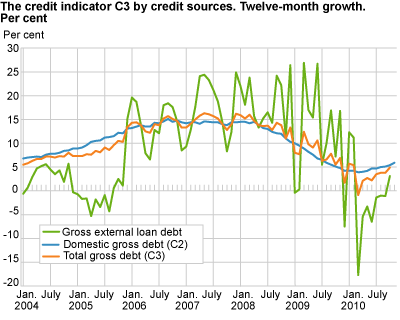Content
Published:
This is an archived release.
Strong increase in foreign debt growth
The twelve-month growth in total gross debt (C3) was 4.9 per cent to end-October, up from 3.8 per cent to end-September. The twelve-month growth in foreign debt was positive for the first time since February 2010.
Total gross debt amounted to NOK 4 433 billion at end-October; a decrease from NOK 4 493 billion at end-September. Eighty-nine per cent of the gross debt came from mainland Norway. The twelve-month growth in total debt from mainland Norway was 5.2 per cent to end-October; up from 5.1 per cent the previous month.
Increase in foreign debt growth stems from offshore industries
The general public gross foreign debt, which mainly relates to non-financial enterprises, amounted to NOK 853 billion in October; down from NOK 936 billion at end-September. The twelve-month growth however increased from -1.1 per cent to 3.1 per cent during October. The twelve-month growth has not been positive since February 2010. The increase in the twelve-month growth is caused by a larger decrease in October 2009 than in October 2010, a so-called basis effect.
Offshore industries accounted for 38 per cent of the public gross foreign debt at end-October, which amounted to NOK 326 billion. The annual growth increased from -8.0 per cent to 0.6 per cent in October. The increase emanates both from long-term and short-term debt, but the short-term debt is by far the largest contributor with nearly 80 per cent.
Mainland Norway accounted for the remainder of the foreign debt, which amounted to NOK 527 billion at end-October. The twelve-month growth in mainland Norway’s foreign debt was 4.6 per cent to end-October; down from 4.9 per cent to the previous month. The decrease emanates from short-term debt.
Increase in domestic gross debt growth
The credit indicator C2 amounted to NOK 3 580 billion at end-October. The twelve-month growth was 5.4 per cent, up from 5.1 the previous month. The debt growth in non-financial enterprises was 2.1 per cent, while the growth in household debt was 6.2 per cent. The C2 statistics show that the annual growth in the general public domestic gross debt increased further to 5.9 per cent to end-November.
| May 2010 | June 2010 | July 2010 | August 2010 | September 2010 | October 2010 | ||||||||||||||||||||||||||||||||||||||||||||||||||||||||||||||||||||||||||
|---|---|---|---|---|---|---|---|---|---|---|---|---|---|---|---|---|---|---|---|---|---|---|---|---|---|---|---|---|---|---|---|---|---|---|---|---|---|---|---|---|---|---|---|---|---|---|---|---|---|---|---|---|---|---|---|---|---|---|---|---|---|---|---|---|---|---|---|---|---|---|---|---|---|---|---|---|---|---|---|
| Total gross debt (C3) | 2.7 | 2.2 | 3.5 | 3.8 | 3.8 | 4.9 | |||||||||||||||||||||||||||||||||||||||||||||||||||||||||||||||||||||||||
| Total gross loan debt, mainland-Norway | 3.5 | 5.2 | 4.6 | 4.4 | 5.1 | 5.2 | |||||||||||||||||||||||||||||||||||||||||||||||||||||||||||||||||||||||||
| Domestic gross debt (C2)1 | 4.2 | 4.7 | 4.7 | 5.0 | 5.1 | 5.4 | |||||||||||||||||||||||||||||||||||||||||||||||||||||||||||||||||||||||||
| Gross external loan debt | -3.3 | -6.5 | -1.4 | -1.0 | -1.1 | 3.1 | |||||||||||||||||||||||||||||||||||||||||||||||||||||||||||||||||||||||||
| Gross external loan debt, offshore ind. | -8.5 | -21.4 | -9.1 | -3.3 | -8.0 | 0.6 | |||||||||||||||||||||||||||||||||||||||||||||||||||||||||||||||||||||||||
| Gross ext. loan debt, mainland-Norway | 0.1 | 8.8 | 4.1 | 0.5 | 4.9 | 4.6 | |||||||||||||||||||||||||||||||||||||||||||||||||||||||||||||||||||||||||
| 1 | The growth rates for C2 are in the table presented as they were at the time of the C3 release. |
|
The statistics for external loan debt are based on samples, and therefore associated with more uncertainty than the statistics for domestic debt (C2). For more details concerning sampling, see chapter 3.3 in About the statistics . |
|
C3 is an approximate measure of the size of the total gross debt of the public (households, non-financial enterprises and municipalities) in NOK and foreign exchange. C3 comprises the sum of C2 (the public’s domestic gross debt) and the public’s external loan debt, of which C2 constitutes the largest part. The C3 statistics are published approximately one month later than C2.
It should be noted that the growth rates for the public’s gross external loan debt vary from month to month due to shifting amounts of short-time internal debt by oil companies. In addition, the first-time-published growth rates are often revised at a later date due to improved information. |
Tables
The statistics is now published as Credit indicator.
Contact
-
Statistics Norway's Information Centre
E-mail: informasjon@ssb.no
tel.: (+47) 21 09 46 42

